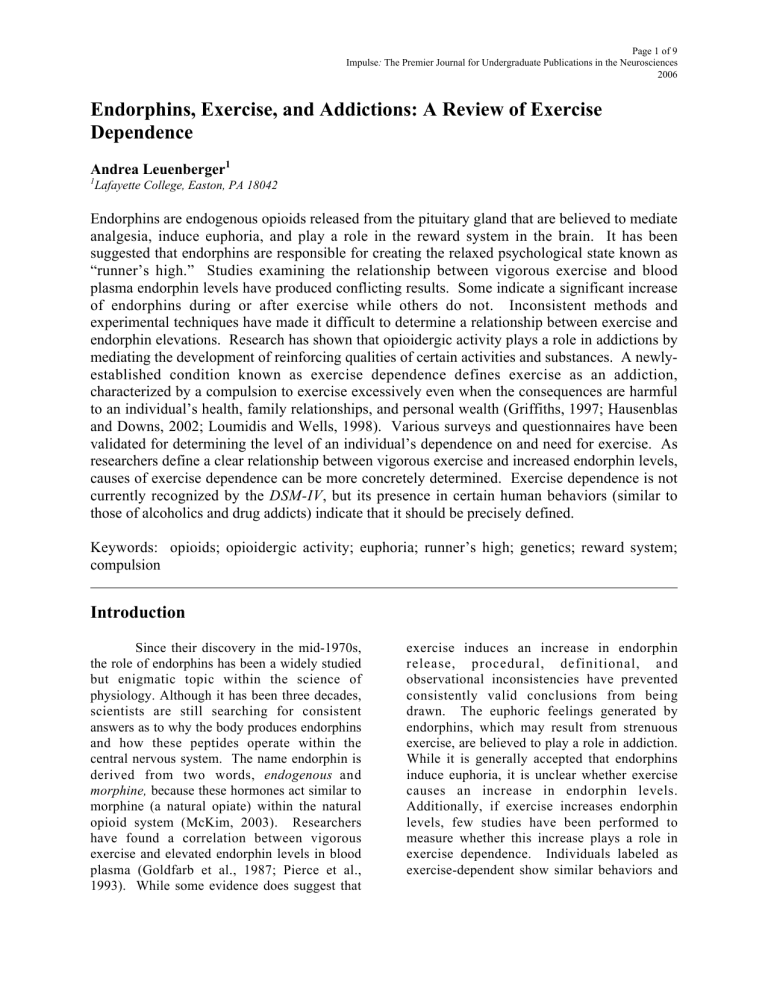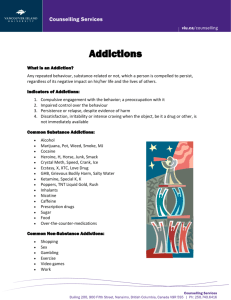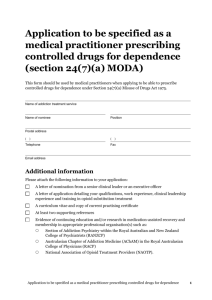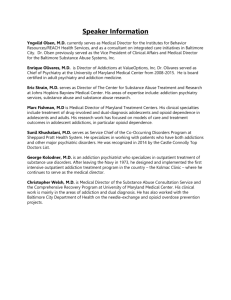Endorphins, Exercise, and Addictions

Page 1 of 9
Impulse : The Premier Journal for Undergraduate Publications in the Neurosciences
2006
Endorphins, Exercise, and Addictions: A Review of Exercise
Dependence
Andrea Leuenberger
1
1 Lafayette College, Easton, PA 18042
Endorphins are endogenous opioids released from the pituitary gland that are believed to mediate analgesia, induce euphoria, and play a role in the reward system in the brain. It has been suggested that endorphins are responsible for creating the relaxed psychological state known as
“runner’s high.” Studies examining the relationship between vigorous exercise and blood plasma endorphin levels have produced conflicting results. Some indicate a significant increase of endorphins during or after exercise while others do not. Inconsistent methods and experimental techniques have made it difficult to determine a relationship between exercise and endorphin elevations. Research has shown that opioidergic activity plays a role in addictions by mediating the development of reinforcing qualities of certain activities and substances. A newlyestablished condition known as exercise dependence defines exercise as an addiction, characterized by a compulsion to exercise excessively even when the consequences are harmful to an individual’s health, family relationships, and personal wealth (Griffiths, 1997; Hausenblas and Downs, 2002; Loumidis and Wells, 1998). Various surveys and questionnaires have been validated for determining the level of an individual’s dependence on and need for exercise. As researchers define a clear relationship between vigorous exercise and increased endorphin levels, causes of exercise dependence can be more concretely determined. Exercise dependence is not currently recognized by the
DSM-IV
, but its presence in certain human behaviors (similar to those of alcoholics and drug addicts) indicate that it should be precisely defined.
Keywords: opioids; opioidergic activity; euphoria; runner’s high; genetics; reward system; compulsion
Introduction
Since their discovery in the mid-1970s, the role of endorphins has been a widely studied but enigmatic topic within the science of physiology. Although it has been three decades, scientists are still searching for consistent answers as to why the body produces endorphins and how these peptides operate within the central nervous system. The name endorphin is derived from two words, endogenous and morphine, because these hormones act similar to morphine (a natural opiate) within the natural opioid system (McKim, 2003). Researchers have found a correlation between vigorous exercise and elevated endorphin levels in blood plasma (Goldfarb et al., 1987; Pierce et al.,
1993). While some evidence does suggest that exercise induces an increase in endorphin release, procedural, definitional, and observational inconsistencies have prevented consistently valid conclusions from being drawn. The euphoric feelings generated by endorphins, which may result from strenuous exercise, are believed to play a role in addiction.
While it is generally accepted that endorphins induce euphoria, it is unclear whether exercise causes an increase in endorphin levels.
Additionally, if exercise increases endorphin levels, few studies have been performed to measure whether this increase plays a role in exercise dependence. Individuals labeled as exercise-dependent show similar behaviors and
hormone levels to those with alcoholism and drug addictions.
Because findings of endorphin elevations are so inconsistent, researchers continually alter experimental strategies.
Unfortunately, this makes it difficult to determine what, if any, strategies effectively measure endorphins and the physiological response to exercise. Based on the literature reviewed, it appears that endorphin activity may be highly variable from one individual to the next, making this analysis even more complex
(Goldfarb et al., 1987). Many researchers have not found significantly elevated endorphin levels after exercise, but many studies do, in fact, indicate a non-significant trend of this occurrence (Di Luigi et al, 2003; Goldfarb et al.,
1998; Langenfeld et al., 1987).
Endorphins: Endogenous Opioids
Endorphins are part of a general class of hormones known as endogenous opioids, a group which also includes enkephalins and dynorphins. The endorphin opioid consists of a specific 31-amino acid sequence, cleaved from a larger peptide known as proopiomelanocortin
(POMC) (Goldfarb et al., 1987; Harbach et al.,
2000). Endorphins are released from the pituitary gland into the circulatory system.
Neurons producing endorphins are located mainly in the ventomedial arcuate nucleus, which projects to the hypothalamus and limbic system (Oswald & Wand, 2004). Opioid peptides activate three different types of receptors, mu ( µ ), kappa (_), and delta (_) receptors, all of which act through a second messenger (McKim, 2003; Zalewska-Kaszubska and Czarnecka, 2005). The affinity with which each opioid binds to the three different receptors can vary; endorphins primarily operate via the
µ -opioid receptor (McKim, 2003). This receptor is known to mediate analgesic effects as well as play a role in the reward system within the brain.
Evidence showing that endorphins can interfere with the release of other neurotransmitters, including norepinephrine, dopamine, and acetylcholine, have led to a belief that they work by modulating the presynaptic membranes of synapses other than their own (McKim, 2003).
Page 2 of 9
Endorphins, Exercise, and Addictions
2006
Opioid antagonists, including naloxone, naltrexone, and nalmefene, have all been shown to block opioid receptors in both animal models and human studies (Dishman, 1985; Farrell,
1985; O’Brien, 2004; Oswald and Wand, 2004).
Naloxone is the most commonly used opioid antagonist in clinical studies as well as addiction treatment (O’Brien, 2004).
Exercise May Increase Endorphin
Release
Many studies have examined the relationship between exercise and endorphin release, studying the role of these peptides in exercise-induced euphoria as well as the reduction of pain (Farrell, 1985; Goldfarb et al.,
1987; Goldfarb et al., 1998 Langenfeld et al.,
1987, Pierce et al., 1993). Endorphins are often implicated in the euphoria known as “runner’s high,” the relaxed psychological state sometimes experienced during or after vigorous exercise such as running (Pierce et al., 1993).
Inconsistent evidence for a significant rise in endorphin release, however, makes it very difficult to simply deduce that endorphins released due to exercise are the cause of euphoric feelings. In addition, Dishman (1985) maintains that the so-called “runner’s high” has not been systematically nor thoroughly documented.
Similar to the euphoria data, results from studies on pain reduction are also conflicting due to inconsistent experimental methods and results. In one study, subjects who ran 1.6 km at a self-selected pace took significantly longer to report pain on their fingertip from a 1.2-kg weight. The analgesia, however, was reduced when a 2-mg dose of naloxone was administered; a 10-mg dose of the drug eliminated the analgesic effects altogether
(Farrell, 1985). This indicates that the endorphins released as a result of running could be responsible for the reduced pain sensitivity.
However, this experiment has not been replicated and follow-up studies have not examined this exact response. Non-replicated experiments, such as this one, and minimal data
make it difficult to confidently formulate a relationship between running and analgesia.
Clinical research studies measuring endorphin levels before, during, and after exercise are conflicting: some show significant increases where others do not. Additional complications occur when researchers differ in their definitions as to what constitutes acute, vigorous exercise. It still remains questionable as to what specific conditions, if any, induce endorphin release. It is possible that a specific
VO
2max
threshold must be met or maintained, a certain distance or length of time must be completed, or a specific form of exercise must be performed in order for the physiological response of endorphin release to occur.
Farrell (1985) assessed the threshold by looking at the effects of intensity and distance of running on endorphin-release in male subjects by compiling results from multiple studies with varied time and distances of running. Analyses of these data indicated a trend of elevated endorphin levels after exercise in all studies, although not all were significant. Pierce et al.
(1993) performed a study measuring plasma endorphin levels before and after endurance exercise, defined as 45 minutes of high-intensity aerobics. Results indicated a significant increase in endorphin levels after the exercise as compared to levels before. Such findings support the idea that opioid peptides may be released as a result of exercising vigorously for a specific amount of time. A study by Goldfarb et al. (1998) agrees with the conclusion, but claims that a critical intensity of exercise must be attained to induce elevations in plasma endorphin levels. However, contrary to the data by Goldfarb et al. (1998), Farrell’s (1985) evidence infers that the increases in endorphin release did not appear to be dependent on the intensity of running.
Goldfarb et al. (1987) chose to assess endorphin levels during an exercise test where subjects experienced an increase in bicycle resistance every 3 minutes until fatigue or their individual VO
2max
was attained. Endorphins were measured before, during, and after exercise. The endorphin response in each individual varied greatly, making it difficult for relationships to be discovered and validated.
Some indicated a significant increase early in the
Page 3 of 9
Impulse : The Premier Journal for Undergraduate Publications in the Neurosciences
2006 test, others late in the test, and some not at all.
While overall endorphin level increases did not prove significant during exercise and at varying intensities, investigators found a significant elevation following the exercise period.
However, the large amount of variability between subjects may indicate different individual responses to different types of exercise.
While much data has been published about the relationship between endorphins and intensity of exercise, other researchers tested different forms of exercise – mostly the difference between running and bicycling.
Langenfeld et al. (1987) sought to determine whether bicycling or running at 60% VO
2max
at a fixed time (1 hr) would significantly elevate endorphin levels and, if so, which form of exercise was more effective. While a trend of increased endorphin levels was observed, statistical analyses did not reveal significance.
One might question, however, if this is due to the fact that an intensity of 60% VO
2max
is possibly insufficient to significantly increase endorphin release; perhaps a greater effort would be necessary. In fact, Pierce et al. (1993) have asserted that a 70% VO is required to significantly elevate endorphin levels in the blood plasma.
All these studies demonstrate a variety of measurements on human participants examining endorphin activity. None indicate strong evidence of increased endorphin release as a result of vigorous exercise, although many suggest trends of such a response. This trend is evidence enough to compel researchers to continually question if such a response exists.
Unfortunately, experimental inconsistencies make it nearly impossible to draw a distinct relationship between exercise and elevations in endorphin blood plasma levels.
Another factor that may cause variability in measurement of endorphin levels is the technique used to measure levels of the hormone in blood plasma. Generally, radioimmunoassay (RIA) is the accepted method of measurement. In examining the studies, there were differences noted in the testing procedures from the different studies, which could very easily have had an effect on the data. An inability to find a consistent link between
Page 4 of 9
Endorphins, Exercise, and Addictions
2006
Figure 1.
Diagram of the brain circuits involved in the motivation system that influences behavior (modified from McKim,
2003). This motivation system is responsible for the development of addictions. As described, it is believed that not only the dopaminergic, but also the opioidergic systems are involved in these processes.
increased endorphin levels and exercise may indicate that blood plasma levels are not the best measure of endorphin levels. Thus, the methods of testing blood plasma may not be sufficient for determining the amount of endorphin released by the pituitary.
The Role of Endorphins in
Addictions
Within the past several decades, research on addictions and the neurobiology of such behaviors has become a major focus for scientists. In today’s society, addicts are often ostracized for their problem. However, recent research indicates that addictions may be due to altered neural processes and can be defined as a disease rather than simply as lack of willpower or morals. For this reason, neuroscientists are now hoping to determine the mechanisms within the brain that are associated with addiction.
Addiction occurs when adaptive changes in the brain cause symptoms of tolerance, sensitization, dependence, and withdrawal. Tolerance is the inability to attain the same effects of a drug or the necessity to increase its dosage as a result of its repeated use, while sensitization is the increased effect of a drug as a result of repeated administration.
Because both tolerance and sensitization can cause an individual to increase drug doses, they can be difficult to differentiate. Two of the most
Page 5 of 9
Impulse : The Premier Journal for Undergraduate Publications in the Neurosciences
2006 defining characteristics of an addiction include the inability to suppress drug-seeking behaviors as well as the occurrence of relapse. Relapse has been found to be a result of repeated use, genetic predisposition, and conditioned associations (Kalivas and Volkow, 2005). Two things occur as the brain adapts to the effects of repeatedly using a drug. First, tolerance begins to develop (Nestler and Landsman, 2001).
Secondly, abstaining from using the drug causes withdrawal symptoms which can be both psychological and physiological in nature.
More recently, addictions have been found to involve learning behaviors that are rewarding to an organism. Two neurotransmitter systems appear to be involved in addictions – the dopaminergic and the opioidergic systems. The ventral tegmental area and the nucleus accumbens are two of the brain regions that are involved in the reward circuit of the central nervous system; collectively, they form the mesolimbic dopamine system. Groups of cell bodies in the ventral tegmental area synapse in the nucleus accumbens and release dopamine when an individual administers an addictive drug (McKim, 2003; Kalivas and
Volkow, 2005; Hyman, 2005). The amygdala to be more likely to become alcoholics due to an increased sensitivity to ethanol.
Understanding the influence of genetics on behavior has become very important when studying addictions to behaviors such as taking drugs. It has been found that certain individuals become addicts after only one exposure to a drug while others never experience addictive characteristics. Continuing research has led to a widespread belief that certain individuals have a predisposition to addiction, such that if they come into contact with a specific substance to which they are vulnerable, they are more likely to become addicted. While it varies with each particular substance under consideration, a heritability risk factor of 40-60% has been determined as the contribution of genetics in addictive behaviors (Volkow, 2005). In addition, a genetic study on externalizing disorders (specifically alcohol dependence, drug dependence, conduct disorder, and adult antisocial behavior) indicated a high heritability factor ( h 2 = .80) among monozygotic twins for heritability of such a disorder (Hicks et al., and hippocampus are additional brain regions that create reinforcing associations in an individual’s memory (McKim, 2003; Kalivas and Volkow, 2005). For this reason, dopamine is believed to be a major component within the process of addictions.
Research on opioid activity suggests its influence on addiction as well. Studies using opioid antagonists have shown a blockade of opioid-induced dopamine release in the nucleus accumbens, indicating that this system influences drug addiction. It appears that opioids act directly in the nucleus accumbens
(Hyman, 2005). In addition, opioids have been directly linked to a specific addiction, alcoholism. As Oswald and Wand (2004) have reported, ethanol appears to increase opioid neurotransmission when consumed. They have also demonstrated, using gene knockout animal models, that the µ -opioid receptor is very likely to be involved in the development of addictions because µ -knockout mice do not respond to ethanol and do not become addicted. In addition, differences among individuals in their baseline opioid activity have been found to influence addictions as well. Individuals with low baseline endorphin levels have been found
2004). These data indicate that while genetics cannot predetermine an addiction, they have a major impact on behavior and risk factors for addictions.
As previously mentioned, multiple studies support claims that the endogenous opioid system is a key factor in generating addictions. Several studies have indicated that individuals with a family history of alcoholism have lower baseline endorphin levels and much stronger responses to ethanol when consumed
(Oswald and Wand, 2004; O’Brien, 2004). One idea that has some merit is that genetics plays a role in regulating opioid activity, causing certain people to be more vulnerable to addictions
(Oswald and Wand, 2004; O’Brien, 2004).
Oswald and Wand (2004) have proposed two hypotheses to demonstrate the means by which the endogenous opioid system works in the case of alcoholism. Firstly, the Opioid
Deficit Hypothesis suggests that low levels of opioid activity prior to ethanol consumption
(during baseline conditions) generate the motivation for an individual to drink alcohol and
increase opioid activity, a reinforcing event.
The second hypothesis, the Opioid Surfeit
Hypothesis, states that those with a vulnerability to alcoholism, likely due to a genetic predisposition, have excessive resting levels of endogenous opioid activity, creating conditions that enhance the effects of ethanol (Oswald and
Wand, 2004). Yet a third hypothesis, the
Endorphin Compensation Hypothesis, has been proposed by Zalewska-Kaszubska and
Czarnecka (2005). According to this theory, ethanol consumption disrupts homeostasis within the neuroendocrine system and causes an increase in endorphin levels. When withdrawal produces unpleasant feelings, individuals will crave alcohol (or other drugs of abuse) as a means to reduce the discomfort, which endorphins alleviate. This theory coincides with the idea that addictive substances have highly reinforcing effects (McKim, 2003; Kalivas and
Volkow, 2005).
It is interesting to note that addictive behaviors as well as genetics are believed to be associated with eating disorders as well.
Evidence shows that appetite dysfunction (as well as strenuous physical activity) increases the endorphin release (Davis and Claridge, 1998).
Davis and Claridge (1998) have proposed a theory known as the Auto-Addiction Opioid
Model, which suggests that individuals with eating disorders become addicted to the increase in endorphin activity and thus, restrict calories and exercise obsessively. Therefore, if addictions to exercise are theoretically possible, it is plausible to assume that genetics could be a factor in exercise dependence as well.
Exercise Dependence
Various terms have been used to describe exercise in terms of an addiction, including exercise dependence; obligatory, compulsive, or excessive exercise; exercise addiction; commitment to exercise; and habitual exercise (Cox and Orford, 2004; Hausenblas and
Downs, 2002; Loumidis and Wells, 1998; Terry et al., 2004). Unfortunately, research has been limited and sporadic with highly variable results.
In addition, differences between the numerous terms have been poorly defined. Society’s view
Page 6 of 9
Endorphins, Exercise, and Addictions
2006 on addictions, exercise, and general health may be altered if a connection between endorphins and exercise dependence could be confirmed.
Since some evidence affirms the release of endorphins due to vigorous exercise, and opioidergic activity is believed to facilitate addiction, determining a relationship between endorphin release and exercise dependence could be an exciting breakthrough discovery in this major field of study (Goldfarb, 1987;
Farrell, 1985; Oswald and Wand, 2004; Pierce et al., 1993; Zalewska-Kaszubska and Czarnecka,
2005).
Multiple reports of exercise-dependence in humans have been documented, many in the form of case studies. In one instance, a 25-year old female who participated in Jiu-Jitsu as her preferred form of exercise, reported having symptoms of tolerance, withdrawal, loss of control, relapse, and euphoria as a result of her excessive exercise. In addition to spending an unreasonable amount of money to maintain her habit, friend and family relationships were strained to the point of non-existence (Griffiths,
1997). Seeking exercise as a means to alter mood state, especially to experience a euphoric
“high” or “buzz,” which many habitual exercisers describe as a motivation to exercise, can be labeled as an addictive behavior.
Ironically, more times than not, individuals do not even experience the high and may even be harming their bodies in the process (Dishman,
1985).
As described by Griffiths (1997) and
Hausenblas and Downs (2002), the idea of exercise being an addiction has existed since the
1970’s when Baekeland studied sleep patterns during exercise deprivation. Baekeland’s study defined the “exercise dependent” group as exercising 5 or more days a week.
Unfortunately, it was difficult to recruit exercise dependent participants because individuals who fit the criteria refused to refrain from exercise for one month. The participants who agreed to abstain from exercise had an exercise routine of approximately 3-4 days per week. Interestingly, even at this lower level of exercise, these participants did report withdrawal symptoms and trouble sleeping (Hausenblas and Downs, 2002).
Later research, however, is conflicting.
Pierce et al. (1993) claim that endorphins have
shown the ability to create addictive behavioral tendencies in individuals. However, their study
(which did demonstrate an increase in endorphin levels after high-intensity aerobics) did not find a significant relationship between endorphin increase and exercise dependence. These results were based on an exercise-dependence survey taken before the exercise.
Animal studies have been more effective in finding a link between endorphins produced during exercise and dependence. Studies of opiate binding in the brains of mice who were exposed to warm water swimming found the antinociception (the inability to experience pain) from exercising to be correlated with an increase in endogenous opiate binding (Farrell, 1985).
Behavior of the mice after chronic exposure to the warm water swimming and subsequent abstinence from the activity was similar to that of morphine withdrawal. This indicates a dependence on exercise as a result of opioid activity.
Because of the newness of research examining this condition and the complexity of varied methodologies, it remains difficult to ascertain what exactly causes exercise dependence and if endorphins play a role.
Further research, consistent findings, and thorough documentation would alleviate questions within this area of study.
Compromising on an official term and definition is one of the fundamental actions that must be taken in order for research to be constructive and consistent enough to form conclusions.
To provide consistency in human studies, questionnaires and inventories have been created to qualitatively measure exercise dependence. The validation and use of such questionnaires can provide further insights about whether a dependence on exercise exists and in what types of people. Researchers could use these questionnaires to determine how these behaviors affect the well-being of “exercise addicts” and whether or not they are harmful.
These exercise dependence surveys have been modeled after the DSM-IV criteria for substance abuse as well as other questionnaires addressing eating disorders. Questions are created to fall within categories addressing characteristics of dependence, including salience, conflict, mood modification, tolerance, withdrawal, and relapse
Page 7 of 9
Impulse : The Premier Journal for Undergraduate Publications in the Neurosciences
2006
(Terry et al., 2005). Specific questionnaires that have been validated include the Leisure-Time
Exercise Questionnaire (LTEQ), Self-efficacy
Questionnaire, Exercise Dependence
Questionnaire, Exercise Dependence Inventory, and the Exercise Beliefs Questionnaire (EBQ)
(Terry et al., 2004; Hausenblas and Downs,
2002; Loumidis and Wells, 1998). In addition, questionnaires addressing the concept of obligatory exercise, a concept similar to exercise dependence, would be useful for studying addictions to exercise. These questionnaires include the Obligatory Exercise Questionnaire,
Obligatory Running Questionnaire , Commitment to Running Scale , and the Running Addiction
Scale (Hausenblas and Downs, 2002).
Implications of Current Research
The previous research on exercise, endorphins, and addictions provides a solid foundation based upon which several ideas can be established. Although further research is necessary, if endorphin release is increased as a result of exercise, it could play a possible role in the development of exercise dependence, seeing as endorphins are believed to facilitate addiction.
By expanding upon the research that indicates an increase in endorphin levels after exercise, welldocumented evidence will make a relationship much more apparent and credible. It appears that in some cases, exercise can elevate endorphin levels. Methodical research is the next step to pinpointing the circumstances that cause such an increase.
As exercise dependence becomes more clearly defined, there are two issues that must be addressed. First, the existence of such a condition must be assessed to determine if it is harmful or healthy. Second, it may prove necessary to devise a treatment plan for those addicted to exercise if the addiction is harmful to their health. Determining the genetic influence on people afflicted with such a condition can lead to prevention and early detection of exercise dependence for individuals believed to have a high risk for the development of exercise dependence. Solid evidence determining a relationship between endorphins and addictive behavior may illustrate to society that addictions
have neurobiological foundations and are not necessarily determined by will-power of an individual. A better understanding of the endogenous opioid system would greatly improve the understanding of endorphins and exercise dependence in humans. Narrowing the definition and acknowledging exercise dependence as a behavioral disorder will certainly further these research efforts.
References
Cox R, Orford J (2004) A qualitative study of the meaning of exercise for people who could be labeled as ‘addicted’ to exercise – can
‘addiction’ be applied to high frequency exercising? Addict Res Theory 12:167-188.
Davis C, Claridge G (1998) The eating disorders as addiction: a psychobiological perspective. Addict Behav 23:463-475.
Di Luigi L, Guidetti L, Baldari C, Romanelli C
(2003) Heredity and pituitary response to exercise-related stress in trained men. Int J
Sports Med 24:551-558.
Dishman RK (1985) Medical psychology in exercise and sport. Med Clin N Am 69:123-
143.
Farrell PA (1985) Exercise and endorphins – male responses. Med Sci Sports Exerc 17:89-
93.
Goldfarb AH, Hatfield BD, Sforzo GA, Flynn
MG (1987) Serum _-endorphin levels during a graded exercise test to exhaustion. Med Sci
Sports Exerc 19:78-82.
Goldfarb AH, Jamurtas AZ, Kamimori GH,
Hegde S, Otterstetter R, Brown DA (1998)
Gender effect on beta-endorphin response to exercise. Med Sci Sports Exerc 30:1672-
1676.
Griffiths M (1997) Exercise addiction: a case study. Addict Res 5:161-168.
Harbach H, Hell K, Gramsch C, Katz N,
Hempelmann G, Teschemacher H (2000) _endorphin (1-31) in the plasma of male volunteers undergoing physical exercise.
Psychoneuroendocrinology 25:551-562.
Hausenblas HA, Downs DS (2002) Exercise dependence: a systematic review. Psychol
Sport Exerc 3:89-123.
Page 8 of 9
Endorphins, Exercise, and Addictions
2006
Hicks BM, Krueger RF, Iacono WG, McGue M,
Patrick CJ (2004) Family transmission and heritability of externalizing disorders: a twinfamily study. Arc Gen Psychiatry 61:922-928.
Hyman SE (2005) Addiction: a disease of learning and memory. Am J Psychiatry
162:1414-1422.
Kalivas PW, Volkow ND (2005) The neural basis of addiction: a pathology of motivation and choice. Am J Psychiatry 162:1403-1413.
Langenfeld ME, Hart LS, Kao PC (1987)
Plasma _-endorphin responses to one-hour bicycling and running at 60% VO
2max
. Med
Sci Sports Med 19:83-86.
Loumidis KS, Wells A (1998) Assessment of beliefs in exercise dependence: the development and preliminary validation of the exercise beliefs questionnaire. Pers Individ
Dif 25:553-567.
McKim WA (2003) Drugs and behavior: an introduction to behavioral pharmacology (5 th ed.). New Jersey: Prentice Hall.
Nestler EJ, Landsman D (2001) Learning about addiction from the genome. Nature 409:834-
835.
O’Brien CP (2004) The mosaic of addiction.
Am J Psychol 161:1741-1742.
Oswald LM, Wand GS (2004) Opioids and alcoholism. Physiol Behav 81:339-358.
Pierce EF, Eastman NW, Tripathi HL, Olson
KG, Dewey WL (1993) _-endorphin response to endurance exercise: relationship to exercise dependence. Percept Mot Skills
77:767-770.
Terry A, Szabo A, Griffiths M (2004) The exercise addiction inventory: a new brief screening tool. Addict Res Theory 12:489-
499.
Volkow ND (2005) What do we know about drug addiction? Am J Psychiatry 162:1401-
1402.
Zalewska-Kaszubska J, Czarnecka E (2005)
Deficit in beta-endorphin peptide and tendency to alcohol abuse. Peptides 26:701-705.
Acknowledgements
I thank Dr. Elaine Reynolds for her input and guidance.
Corresponding Author
Andrea Leuenberger
Lafayette College
Leuenbea@lafayette.edu
345 Laurel Drive
Hershey, PA 17033
Page 9 of 9
Impulse : The Premier Journal for Undergraduate Publications in the Neurosciences
2006






